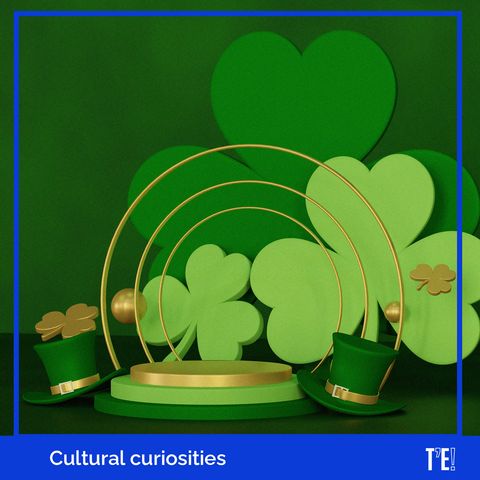Hello and welcome to this podcast brought to you by That's English!, the Spanish Ministry of Education's official distance learning English course. To find out more about That's English! go to www.thatsenglish.com or contact your local Official School of Languages. Welcome to the first part of this podcast about St. Patrick's Day, where we are going to talk about the background to this universal Irish celebration. St. Patrick's Day has been celebrated on 17th March since the seventh century. St. Patrick is believed to have died on this date in 461 AD, and even though he was never formally canonised, he is viewed by many Catholics as a saint and is one of Ireland's patron saints. It is Ireland's national day and you've probably seen people in parades wearing green, leprechaun hats and shamrocks, which we'll explain later, and drinking beer. If, on any normal day of the year, 5.5 million pints of Guinness are consumed, on St. Patrick's Day, or Paddies Day, as it is also called, this figure skyrockets to 13 million pints. This, however, has not always been the case. For the first 60 years of the twentieth century, Irish law banned the consumption of alcohol on St. Patrick's Day as it was a religious celebration and all pubs had to close. This changed when the festivity was declared a national holiday in 1970 and Guinness could flow freely once again. St. Patrick's Day is as popular in the United States as in Ireland itself and some traditions such as drinking green beer or eating corned beef and cabbage are in fact of Irish-American origin. Indeed, it is said that there are more Irish in the U.S. than in Ireland itself. An estimated 34 million Americans are of Irish descent and some 122 million Americans, 39% of the population, say that they celebrate St. Patrick's Day in some way, making special dinners, wearing green or sending good luck cards with shamrocks. According to history.com in the US nearly 650,000 babies have been given the name of Patrick over the last 100 years and there are over 450 churches consecrated under the name of the saint. Behind these statistics lies the dramatic and often tragic history of Irish emigration to the US: from colonial times when Irish men and women were sent by the British as slaves to work on the plantations to the diaspora of the mid-19th century when approximately one million Irish citizens emigrated to the United States to escape the starvation and the appalling living conditions caused by the Potato Famine. In the 1860s, the German philosopher Frederick Engels, whose wife was Irish, is reported to have said: "If this goes on for another thirty years, there will be Irishmen only in America." In the light of this, it is easy to understand why St. Patrick's Day is such an important celebration in the States. So who was St. Patrick? Maybe one of the most surprising things about him is that he was not Irish at all. St. Patrick was born in 385 AD in Roman Britain. We don't know exactly where he was born - some say it was in what is now Wales and others in Scotland, but he is thought to have come from an aristocratic Christian family. Even though Patrick was to become a saint of the Catholic Church, as a young lad it seems he showed no particular interest in religion. However, when he was sixteen years old he was kidnapped by raiders and taken to Ireland where he was sold as a slave. He spent six years in captivity herding sheep until he managed to escape back to Britain, at the age of twenty two. Once back in Britain, he entered a monastery to study to be a priest and 12 years later he is said to have been visited by an angel who told him to go back to Ireland to work as a missionary. St. Patrick spent the rest of his life working to spread the Christian faith in a country which had a pagan Celtic culture. According to legend, he is reported to have baptised 12,000 people on one day and to have consecrated more than 350 bishops in his lifetime. He is also said to have rid Ireland of snakes by driving them into the sea. However, scientists say that snakes have never lived in the wild in Ireland. There are other islands in the world that don’t have snakes either such as New Zealand, Greenland and Iceland. So it seems that the "snakes" St. Patrick eradicated were, in fact, the pagan beliefs that were common in Ireland at the time. Nevertheless, St. Patrick was respectful of Celtic culture and an example of this is the Celtic Cross: he incorporated the sun, an important feature of Celt culture, onto the cross to create a symbol of Christianity, which would be more familiar for the Irish people. So, if you would like to learn more about St. Patrick's Day, don't miss the second part of this podcast where we will talk about some of the ways St. Patrick's Day is celebrated, particularly in Ireland and the United States. We hope you have enjoyed this podcast, brought to you by That's English! Please follow us on Facebook and Twitter. We look forward to hearing from you. Bye for now! Glossary: leprechaun - an elf-like creature in Irish folklore shamrock - a type of clover.
show less

